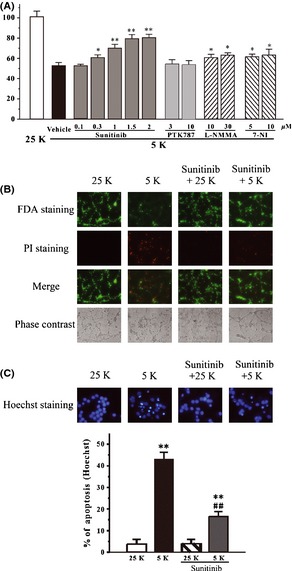Figure 1.

Sunitinib blocks low‐potassium‐induced neuronal apoptosis in CGNs. (A) Sunitinib, but not PTK787, prevented low‐potassium‐induced neuronal death in a concentration‐dependent manner. At 8 days in vitro, CGNs were switched to 5K medium containing sunitinib, PTK787, L‐NMMA, 7‐NI, or DMSO (0.05%; vehicle control; black bar) at indicated concentrations. CGNs placed at 25K medium (white bar) were regarded as a control. Cell viability was measured by MTT assay at 24 h after low‐potassium challenge. (B) Sunitinib blocked neuronal death induced by low potassium. CGNs were switched to 5K or 25K medium with or without 1.5 μM sunitinib. After 24 h of low‐potassium challenge, CGNs were assayed with FDA/PI double staining. (C) Sunitinib reversed the morphological alteration induced by low potassium. CGNs were switched to 5K or 25K medium with or without 1.5 μM sunitinib. After 24 h of low‐potassium challenge, CGNs were assayed with Hoechst staining. The number of pyknotic nuclei with condensed chromatin were counted from representative Hoechst staining photomicrographs and represented as a percentage of the total number of nuclei counted. Data, expressed as percentage of control (CGNs were cultured in 25K medium), were the mean ± SEM of three separate experiments; *P < 0.05 and **P < 0.01 versus 5K group in (A) or versus control in (C); ## P < 0.01 versus 5K group in (C) (Tukey's test). CGNs, Cerebellar granule neurons.
